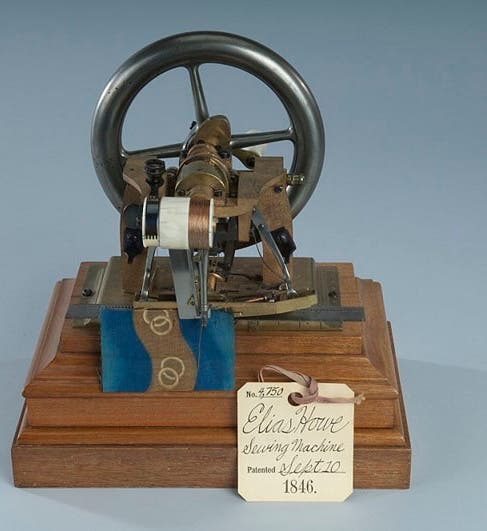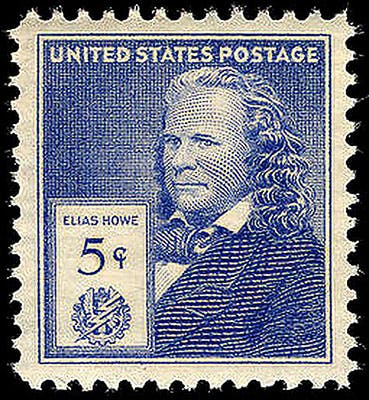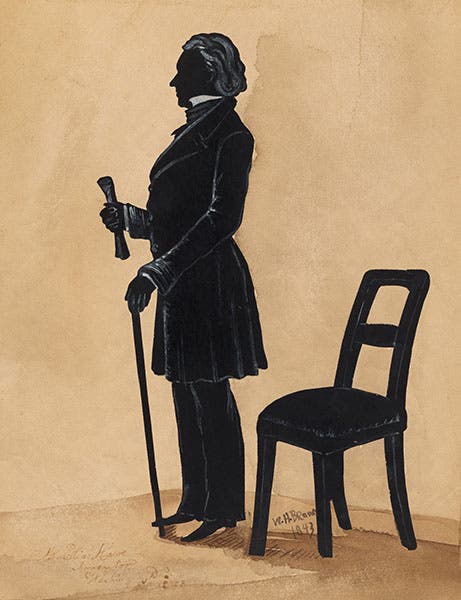Scientist of the Day - Elias Howe
Elias Howe, Jr., an American inventor, was born July 9, 1819. Working in a textile factory as a young man, and then as a mechanic and machinist, he got the idea of building a sewing machine when he was just 20 years old, began working seriously on the project when he was 24, and within two years, in 1845, he had a working model. His sewing machine was not the first in the United States. When he received his patent in 1846, it was the fifth sewing machine patent granted by the U.S. Patent Office. His machine used an eye-pointed needle, but Howe did not invent that, and it was not a part of his patent application. His machine sewed with the cloth held vertically, and the curved needle flicked back and forth, sideways. Others had machines with the cloth held horizontally and the needle moving vertically, up and down. So why is Howe generally credited, even by historians of technology, with inventing the sewing machine? Primarily because his machine actually worked, unlike the many others that never got beyond the patent stage. And because his machine used an ingenious back-and-forth shuttle, fed by a bobbin, that produced a lockstitch, rather than the chain-stitch produced by most of his predecessors. A chain-stitched seam can unravel; a lockstitch will not. Moreover, Howe understood all the little things that had to go right for a machine to sew effectively. He understood, for example, that the thread that feeds the needle must have its tension relaxed when the needle penetrates the cloth, so that a loop can form and the shuttle can pass through, and then the tension has to tighten when the needle withdraws, to set the knot. His machine did all the things that were actually necessary to sew two pieces of cloth together, and it was the first to do so in a manner that could be commercialized.
Howe did not want to make his own machines - he wanted to sell licenses to other manufacturers and make his money that way. He found no takers in the U.S., went to England, where he did find willing manufacturers but made no money, and he returned to the U.S. in 1849 to find that others, such as Isaac Singer, were building better machines than his, but were using all his patented inventions without paying any fees. He took Singer and the rest to court and the court agreed with Howe and he won the suit. After 1853, he received $25 for every machine Singer or any other manufacturer sold. Howe became a very wealthy man.
As you probably know, when a patent application was submitted in the 19th century, it had to be accompanied by a model. There was a disastrous fire in the Patent Office in 1836 and all models prior to that date were destroyed. Luckily, Howe’s model, submitted ten years after the fire, still survives (first image). It was not really a model, but the second machine that he built, and it actually worked.
The patent grant of Sept. 10, 1846, has three drawings of Howe’s machine; we include here the second one, which allows us to see the needle sticking out on the right; there is a detail of the back-and-forth shuttle at the bottom (third image, above).
There is a portrait photograph of Howe that is commonly used in biographical articles, such as the one on Wikipedia; you can see it here. I am sure it is authentic – it looks just like Howe – and it is a striking photograph, but it has no documentation that I can find, so I thought I would accompany this post with three more unusual portraits. The first is not that unusual, a U.S. postage stamp of 1940 (second image). But the other two are rarely seen. One (fourth image, above) is a cut-paper silhouette by William Henry Brown in the National Portrait Gallery in Washington. The other is a Duke cigarette card, issued in 1888 (fifth image, below). If nothing else, the card tells us that Howe was relatively well-known as the sewing-machine inventor not too long after his death.
If you would like yet another view of Howe, you may seek out the painting by Christian Schussele, Men of Progress (1862), where, in addition to inventors and moguls such as Samuel F.B. Morse and Peter Cooper, the artist included Howe, at the very far right. The painting is in the National Portrait Gallery in Washington; you may view it here, and consult its description and acquisition history here.
Dr. William B. Ashworth, Jr., Consultant for the History of Science, Linda Hall Library and Associate Professor emeritus, Department of History, University of Missouri-Kansas City. Comments or corrections are welcome; please direct to ashworthw@umkc.edu.










